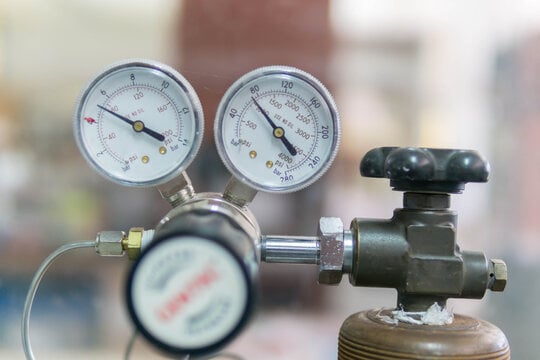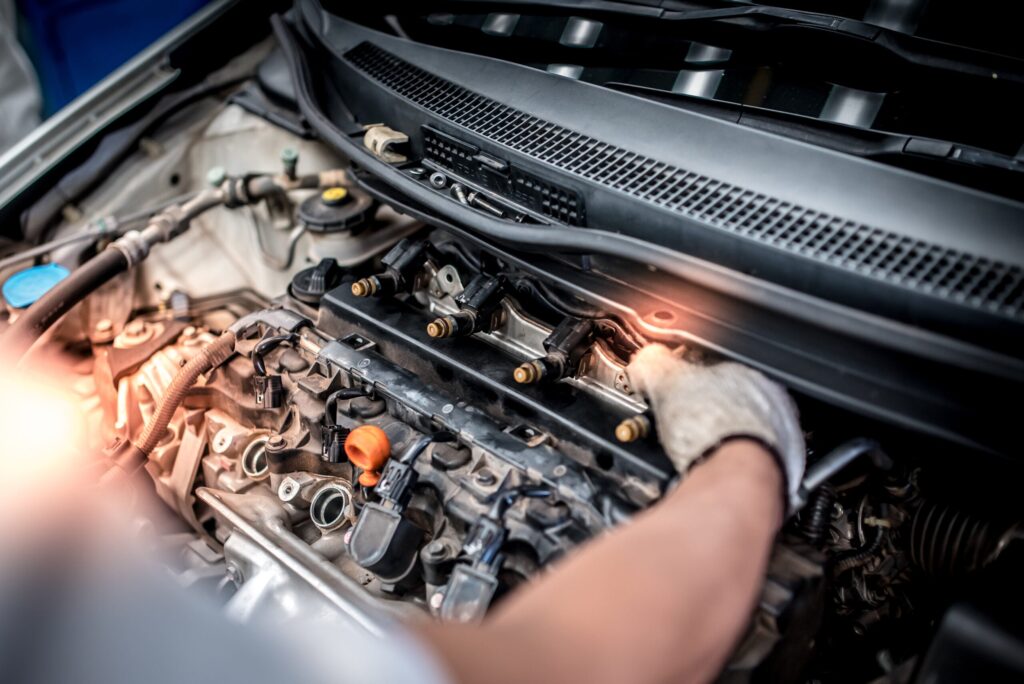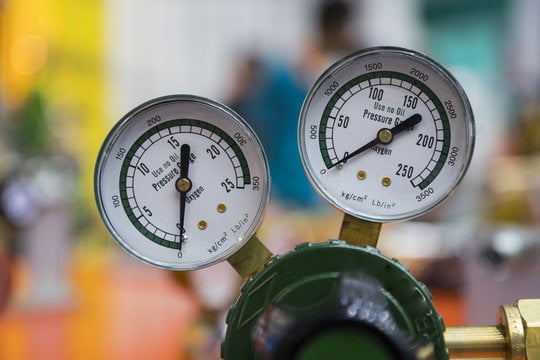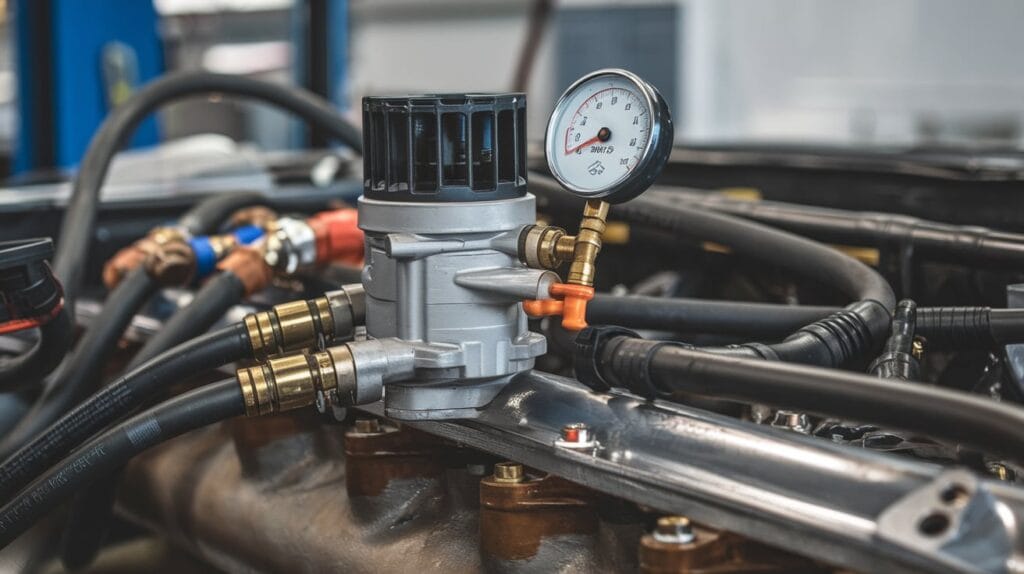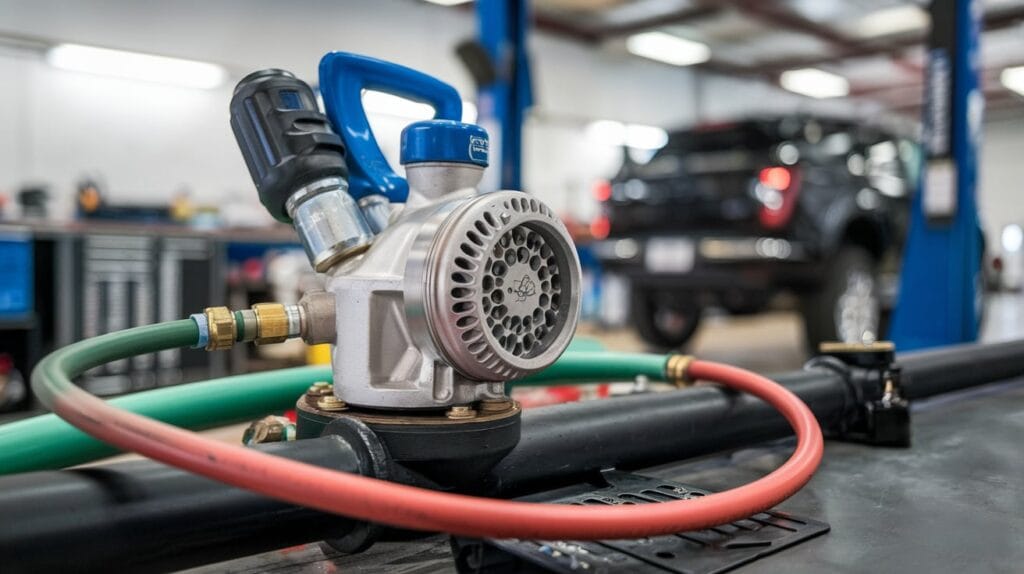Is your car shaking while idle or struggling to start? These could be signs of a bad fuel pressure regulator! Ignoring fuel pressure regulator symptoms can lead to poor performance, reduced fuel efficiency, and costly repairs. Learn how to spot issues like rough idling, black smoke, or fuel leaks caused by a faulty fuel pressure regulator and take action before it’s too late. Stay informed and keep your car running smoothly!
What is a Fuel Pressure Regulator?
A fuel pressure regulator is an essential component in your vehicle’s fuel delivery system. Its main job is to maintain the correct amount of pressure needed to deliver fuel to the engine. By ensuring the right pressure, it helps the engine operate efficiently and smoothly, no matter the driving conditions.
How Does a Fuel Pressure Regulator Work?
The fuel pressure regulator controls the fuel flow from the fuel pump to the engine. It adjusts the pressure by opening or closing a valve—known as the fuel pressure regulator valve—based on the engine’s needs. When the fuel pressure gets too high, the regulator releases excess fuel back into the fuel tank through a return line. If the pressure is too low, it restricts fuel flow to build up the required pressure.
Most regulators use a spring-loaded diaphragm to sense pressure changes. Some modern vehicles rely on electronic sensors to adjust pressure dynamically for optimal performance.
Types of Fuel Pressure Regulators
Fuel pressure regulators come in different types, each designed to suit specific fuel delivery systems and vehicle requirements. Here’s an overview of the main types:
1. Return-Type Fuel Pressure Regulator
This traditional regulator is widely used in older vehicles with a return fuel system. It maintains steady pressure by redirecting excess fuel back to the tank via a return line.
- How It Works:
A spring-loaded diaphragm senses fuel pressure. When pressure exceeds the set limit, the diaphragm opens to allow excess fuel to return to the tank. - Advantages:
Provides stable pressure for consistent engine performance. - Common Applications:
- 1989 Mercedes-Benz models.
- 1990s Ford Mustang models with electronic fuel injection (EFI).
- Early 2000s Toyota 4Runner with return-line systems.
2. Returnless Fuel Pressure Regulator
Modern vehicles favor this design for its simplicity and efficiency. It removes the return line, streamlining the system.
- How It Works:
The regulator is built into the fuel pump assembly, maintaining constant pressure before fuel is delivered to the engine. - Advantages:
Reduces system complexity and heat buildup. - Common Applications:
- 2005 Honda Civic.
- 2001 Chevy Astro Van.
- 2000 Chevy Silverado.
3. Adjustable Fuel Pressure Regulator
This type allows manual adjustment of fuel pressure, making it popular for high-performance and custom vehicles.
- How It Works:
A knob or screw lets users fine-tune pressure to match specific engine performance needs. - Advantages:
Perfect for tuning engines for racing or aftermarket modifications. - Common Applications:
- Fox Body Ford Mustang for drag racing setups.
- Vehicles with Holley carburetors.
- Performance-tuned C5 Corvette models.
4. Mechanical Fuel Pressure Regulator
This regulator is simple and reliable, used in carbureted systems that require low fuel pressure.
- How It Works:
It uses a mechanical diaphragm to regulate the flow of fuel to the carburetor. - Advantages:
Durable and easy to maintain. - Common Applications:
- Classic 1980s Chevrolet Camaro with carburetors.
- Marine engines like Mercruiser systems.
- 22RE Toyota engines (widely used in older trucks).
5. Electronic Fuel Pressure Regulator
These are high-tech regulators used in modern vehicles requiring precise fuel management. They rely on sensors and electronic control for real-time adjustments.
- How It Works:
A sensor monitors fuel pressure and an electronic control unit adjusts the regulator accordingly. - Advantages:
Delivers unmatched precision and efficiency. - Common Applications:
- Hybrid vehicles like the Toyota Prius.
- Advanced BMW 5 Series models.
- Late-model Chevrolet Suburban with electronic fuel injection.
6. Boost-Referenced Fuel Pressure Regulator
Designed for turbocharged and supercharged engines, this regulator adjusts fuel pressure based on boost levels to maintain proper air-fuel ratios under high-performance conditions.
- How It Works:
The regulator increases fuel pressure as the engine boost rises, ensuring enough fuel is delivered during high power output. - Advantages:
Prevents fuel starvation in forced induction engines. - Common Applications:
- Subaru WRX STI turbocharged models.
- Supercharged Dodge Challenger Hellcat.
- Modified Nissan 350Z with turbo upgrades.
7. Rising Rate Fuel Pressure Regulator
A specialized type of boost-referenced regulator, it increases fuel pressure at a higher rate than the boost pressure, often used in racing.
- How It Works:
As boost pressure increases, the regulator amplifies fuel pressure proportionally to meet performance needs. - Advantages:
Ideal for high-output engines with demanding fuel requirements. - Common Applications:
- High-performance Corvette Z06.
- Drag racing setups with LS engines.
- Custom-tuned turbocharged Toyota Supra MK4.
8. Inline Fuel Pressure Regulator
An inline regulator is compact and installed directly in the fuel line, offering versatility for various applications.
- How It Works:
It regulates fuel pressure inline without being part of the fuel rail or pump assembly. - Advantages:
Easy installation in custom or retrofit systems. - Common Applications:
- Aftermarket setups in classic cars like 1967 Ford Mustang.
- Custom EFI conversions for vintage vehicles.
- Motorcycles like Harley-Davidson Touring models.
9. Carburetor-Specific Regulators
These regulators are made for carbureted systems, which require much lower fuel pressure compared to fuel injection systems.
- How It Works:
It reduces high fuel pump pressure to levels that prevent flooding the carburetor. - Advantages:
Ensures smooth operation of carbureted engines. - Common Applications:
- 1970s Chevy C10 Trucks.
- Vintage motorcycles like Honda CB750.
- Marine engines like 3126 CAT diesel.
By understanding the different types of fuel pressure regulators, you can make informed decisions about maintenance, upgrades, or replacements to keep your vehicle running smoothly.
Common Symptoms of a Faulty Fuel Pressure Regulator
A failing fuel pressure regulator can lead to noticeable problems that affect your car’s performance and drivability. Below are the clear warning signs to help you identify issues early:
- Reduced Engine Performance
- A bad fuel pressure regulator can disrupt the fuel delivery, causing poor acceleration and decreased power. This happens because the engine isn’t receiving the precise amount of fuel it needs for efficient combustion.
- Car Shaking While Idle
- When the fuel rail pressure regulator isn’t functioning properly, it can disturb the balance of fuel and air in the engine. This often results in noticeable vibrations or shaking while the car is idling.
- Difficulty Starting the Engine
- Insufficient fuel pressure caused by a faulty fuel pressure regulator can lead to hard starts or even a no-start condition. This is a common issue in vehicles with a malfunctioning fuel pump pressure regulator.
- Black Smoke from the Exhaust
- Excessive fuel delivery caused by a fuel pressure regulator valve issue can result in black smoke, use this black exhaust smoke guide to separate rich-mixture faults from oil-burn issues.This happens when the engine burns more fuel than it needs, which also wastes gas.
- Poor Fuel Economy
- A faulty fuel regulator may deliver too much fuel to the engine, significantly reducing gas mileage. You’ll find yourself refueling more often due to inefficient fuel usage.
- Fuel Leaks
- Visible leaks near the fuel rail pressure regulator or along the fuel line are a clear indicator of a problem. These leaks not only impact performance but also pose serious safety risks.
- Rough Idling and Stalling
- Irregular fuel pressure caused by bad fuel regulator symptoms can make the engine idle unevenly or stall, especially when slowing down or stopping.
- Spark Plug Fouling
- Excess fuel entering the combustion chamber can cause the spark plugs to become coated with black soot, leading to ignition problems. This is a clear sign of a bad fuel pressure regulator.
- Strong Gasoline Odor
- A damaged fuel regulator valve can cause fuel to leak into the vacuum system, resulting in a noticeable gasoline smell inside or around the car.
- Overheating Catalytic Converter
- An overworked catalytic converter can be a side effect of excessive fuel delivery caused by a fuel injection pressure regulator issue. Over time, this can damage the catalytic converter and increase repair costs.
- Check Engine Light
- The vehicle’s diagnostics system may detect issues related to the fuel high pressure regulator and trigger the check engine light. These codes often point to problems with fuel delivery or mixture imbalance.
- Inconsistent Fuel Pressure Readings
- Using a fuel pressure gauge regulator, you may observe fluctuations or readings outside the recommended range, which is a common symptom of a failing boost reference fuel regulator.
If you notice any of these fuel pressure regulator symptoms, it’s important to address the issue promptly. Ignoring these warning signs could lead to engine damage, reduced performance and costly repairs. Always consult a professional mechanic for accurate diagnostics and solutions.
Top 10 Vehicle Models & Their Fuel Regulator Symptoms
Fuel pressure regulator issues manifest differently depending on the vehicle. Here’s a comprehensive guide to model-specific symptoms to help you understand what to look for in various cars, trucks and motorcycles:
1. Mercedes-Benz 1989 Models
Older Mercedes models, such as the 1989 Mercedes-Benz, exhibit unique symptoms due to their mechanical fuel systems:
- Rough idling and frequent stalling due to improper fuel pressure.
- Black smoke from the exhaust, a result of excessive fuel being sent to the engine.
- Hard starting issues, especially after the vehicle has been parked for a while.
2. 2001 Chevy Astro Van
The 2001 Chevy Astro Van frequently encounters problems related to the fuel pump pressure regulator:
- Engine misfires, especially during acceleration.
- Noticeable fuel smell near the engine or exhaust, often caused by regulator leaks.
- Decreased fuel efficiency and sluggish performance, especially when carrying heavy loads.
3. 2000 Chevy Silverado
The 2000 Silverado often displays distinct symptoms when the fuel rail pressure regulator fails:
- Difficulty starting the engine, especially after it has been running hot.
- Visible fuel leaks near the regulator or fuel rail, which can lead to reduced engine power.
- Car shaking while idle and erratic engine behavior.
- A check engine light that may indicate fuel system faults.
4. 2005 Honda Civic
The 2005 Honda Civic, known for its efficient engine, suffers noticeably when the fuel injection pressure regulator malfunctions:
- Poor acceleration and hesitation at higher speeds.
- Excessive fuel consumption, resulting in frequent refueling.
- Black smoke from the exhaust, particularly under hard acceleration.
- A strong fuel odor, caused by leaks in the regulator system.
5. 1990-1995 Ford Mustang
For classic Ford Mustang models, symptoms of a failing boost reference fuel regulator include:
- Engine misfires and uneven throttle response.
- Rough idling and performance dips during acceleration.
- Increased emissions due to improper fuel-air mixtures.
6. 2002-2007 Subaru WRX STI
Turbocharged models like the Subaru WRX STI often experience unique problems due to high-performance demands:
- Fuel starvation during rapid acceleration or under high boost conditions.
- Overheating catalytic converters caused by unburned fuel in the exhaust.
- Rich fuel mixtures, leading to excessive exhaust smoke.
7. 1998-2002 Toyota 4Runner
The Toyota 4Runner, known for its reliability, may show symptoms of a failing fuel regulator sensor:
- Hard starts and rough engine performance.
- Decreased fuel economy, especially during city driving.
- Strong fuel smell from the engine bay due to leaks.
8. 1997-2004 Chevrolet Corvette (C5)
High-performance vehicles like the C5 Corvette depend on consistent fuel pressure for peak performance:
- Engine misfires and reduced acceleration.
- Fluctuating fuel pressure, often caused by a failing high flow fuel pressure regulator.
- Black smoke from the exhaust, signaling fuel delivery problems.
9. 1967-1973 Chevrolet Camaro
Classic muscle cars like the Chevy Camaro with carburetor systems often display these signs:
- Fuel leaks near the carburetor caused by excess pressure.
- Sputtering engine at higher speeds due to improper fuel delivery.
- Difficulty maintaining a steady idle.
10. Harley-Davidson Motorcycles
Harley-Davidson bikes are prone to unique symptoms when their low-pressure fuel regulator malfunctions:
- Sputtering engine and loss of throttle response.
- Poor fuel economy and increased exhaust smoke.
- Hard starting issues, particularly after long rides.
By understanding these model-specific fuel pressure regulator symptoms, you can quickly identify and address issues, ensuring your vehicle runs efficiently. If you encounter any of these signs, consult a professional mechanic for an accurate diagnosis and timely repairs.
Causes of Fuel Pressure Regulator Failure
A fuel pressure regulator can fail due to several reasons, most of which stem from wear, contamination, or damage over time. Here are the main causes of its failure:
- Wear and Tear Over Time
- The fuel pressure regulator is a mechanical part that endures constant use. Over time, its internal components, like the diaphragm or spring, can wear out, leading to poor performance or complete failure.
- Contaminated Fuel
- Dirt, debris, or other impurities in the fuel can clog the regulator or damage its internal mechanisms. Contaminated fuel often results from using low-quality fuel or a failing fuel filter.
- Faulty Vacuum Line
- Many fuel pressure regulators use a vacuum line to help control fuel pressure. If this line is damaged, disconnected or leaking, it can cause the regulator to malfunction.
- Corrosion
- Moisture in the fuel system can lead to rust or corrosion inside the regulator. This is especially common in older vehicles or those exposed to humid conditions.
- High Fuel Pressure
- Excessive pressure from the fuel pump can strain the regulator and cause it to fail. This often happens if the fuel pump is upgraded or replaced with a higher-output model without adjusting the regulator accordingly.
- Electrical Issues
- In modern vehicles with electronic regulators, wiring problems or a faulty control module can disrupt the regulator’s ability to function properly.
- Overheating Fuel System
- An overheated fuel system can damage the regulator, especially if it’s exposed to prolonged high temperatures. This is more common in performance vehicles or those with insufficient cooling systems.
- Lack of Maintenance
- Failing to replace the fuel filter regularly or neglecting general fuel system maintenance can lead to excessive wear on the regulator. Dirt and debris build-up are more likely under these conditions.
By understanding these common causes of fuel pressure regulator failure, you can take steps to prevent issues and maintain the overall health of your vehicle’s fuel system. Regular inspections and timely maintenance are key to avoiding costly repairs.
Having Fuel Pressure Issues? Get Help Now!
Are you noticing issues like car shaking while idle, black smoke from the exhaust, or trouble starting your car? These could be clear signs of a faulty fuel pressure regulator. Ignoring these fuel pressure regulator symptoms can lead to poor performance, reduced fuel efficiency, and even engine damage. Whether it’s a bad fuel pressure regulator or a failing fuel rail pressure regulator, addressing the problem promptly is essential. A professional fuel pressure regulator replacement can restore your car’s performance and prevent costly repairs down the line.
Don’t wait until your vehicle stops running altogether! Our team is here to help with all your fuel system needs, including diagnosing fuel pressure regulator problem symptoms, fixing leaks, and ensuring precise fuel injection pressure regulator performance. If you’re experiencing trouble like fuel pump regulator symptoms or suspect your vehicle needs a fuel regulator replacement, reach out today. Book an inspection now at our workshop to keep your vehicle running smoothly and efficiently!
Maintenance Tips to Avoid Fuel Pressure Regulator Issues
Keeping your fuel pressure regulator in good condition is key to maintaining your car’s performance and preventing costly repairs. By following these simple maintenance tips, you can avoid common fuel pressure regulator problems symptoms and ensure your vehicle runs smoothly.
- Use High-Quality Fuel
- Always use clean, high-quality fuel to avoid contaminants that can clog or damage the fuel injection pressure regulator and other components in the fuel system.
- Replace the Fuel Filter Regularly
- A clean fuel filter helps prevent dirt and debris from reaching the fuel rail pressure regulator, extending its lifespan and ensuring optimal performance.
- Inspect Vacuum Lines and Connections
- Check the vacuum lines connected to the fuel pressure regulator valve for cracks, leaks, or loose fittings. Damaged lines can disrupt the regulator’s functionality.
- Monitor Fuel Pressure with a Gauge
- Regularly check your vehicle’s fuel pressure using a fuel pressure gauge regulator. Inconsistent readings could indicate early signs of a faulty fuel pressure regulator.
- Perform Regular Engine Tune-Ups
- Routine tune-ups can catch early warning signs of bad fuel pressure regulator symptoms, such as rough idling or poor fuel economy, before they worsen.
- Avoid Overloading the Fuel System
- If you’ve upgraded your fuel pump, ensure it’s compatible with your fuel regulator to avoid excessive pressure, which can strain the regulator.
- Schedule Regular Inspections
- Have your vehicle’s fuel system inspected by a professional to detect and address potential issues, like fuel pump pressure regulator symptoms or leaks, before they lead to bigger problems.
By following these maintenance tips, you can extend the life of your fuel pressure regulator, avoid fuel regulator replacement, and keep your vehicle running efficiently. Regular care and attention to your fuel system ensure smooth performance and peace of mind on the road!
A healthy fuel pressure regulator is vital for smooth engine performance and fuel efficiency. Ignoring fuel pressure regulator symptoms, like poor fuel economy or a strong gasoline smell, can lead to serious engine damage and costly repairs. Acting quickly on signs like car shaking while idle or black exhaust smoke helps you avoid bigger problems. Regular maintenance and prompt fuel pressure regulator replacement ensure your vehicle stays reliable and safe. Don’t wait—take care of your fuel system today and enjoy a smoother, worry-free drive!
FAQs About Fuel Pressure Regulators
1. Can a bad fuel pressure regulator cause engine overheating?
Yes, a faulty fuel pressure regulator can lead to engine overheating. If the regulator allows too much fuel into the system, unburned fuel may reach the exhaust, causing the catalytic converter to overheat. This can result in increased engine temperatures and potential damage to the exhaust system.
2. How does a boost reference fuel pressure regulator work?
A boost reference fuel pressure regulator adjusts the fuel pressure based on the boost level in turbocharged or supercharged engines. As the boost increases, the regulator raises fuel pressure to maintain the correct air-fuel ratio, ensuring optimal performance under high-load conditions.
3. What happens if the fuel pressure regulator is stuck open?
If the fuel pressure regulator valve is stuck open, it allows excess fuel to flow into the engine. This can cause symptoms like black smoke, poor fuel economy, and even engine stalling. Over time, it may lead to fuel flooding and damage other engine components.
4. Can a bad fuel pressure regulator damage the fuel pump?
Yes, a faulty fuel regulator can put extra strain on the fuel pump. If the regulator fails to maintain proper pressure, the fuel pump may work harder to compensate, leading to premature wear and potential failure.
5. What is the difference between a fuel regulator for carburetors and fuel-injected systems?
A fuel pressure regulator for carburetors is designed for low-pressure systems and controls fuel flow to prevent flooding. In contrast, a fuel injection pressure regulator manages higher pressures and ensures precise fuel delivery to the injectors for optimal combustion.
6. Are adjustable fuel pressure regulators worth it?
Adjustable fuel regulators are ideal for performance enthusiasts. They allow manual adjustment of fuel pressure to optimize engine performance, especially in modified or high-output vehicles. For everyday cars, a standard regulator is typically sufficient.
7. What causes a fuel pressure regulator to leak fuel?
A leaking fuel pressure regulator is often caused by a damaged diaphragm, cracks in the housing, or worn seals. This can result in fuel escaping into the vacuum line or pooling near the regulator. Prompt replacement is essential to prevent fire hazards.
8. Can a bad fuel pressure regulator cause a rough transmission shift?
Yes, irregular fuel pressure from a bad fuel pressure regulator can disrupt engine performance, indirectly affecting transmission shifts. Smooth fuel delivery is critical for maintaining proper engine load and transmission timing.
9. How often should a fuel pressure regulator be replaced?
While there’s no fixed replacement schedule, it’s advisable to inspect the fuel rail pressure regulator during regular maintenance or if you notice bad fuel regulator symptoms like poor engine performance or fuel leaks. Most regulators last between 100,000 to 150,000 kilometers, depending on driving conditions.
10. Can I drive with a faulty fuel pressure regulator?
Driving with a faulty fuel pressure regulator is not recommended. It can lead to engine misfires, increased fuel consumption, and potential damage to the catalytic converter or fuel pump. Addressing the issue promptly ensures safety and prevents further vehicle damage.

